Taxation of Timber Sales
VerifiedAdded on 2020/03/23
|9
|2029
|30
AI Summary
This assignment examines the taxation implications of selling timber in Australia, focusing on two scenarios: selling standing timber not in the ordinary course of business and selling the rights to extract timber. It analyzes relevant legal provisions (sections 36(1) and 25(1), ruling TR 95/6) and explains how income earned from these transactions is taxable. The document provides a clear understanding of the tax regulations surrounding timber sales in Australia.
Contribute Materials
Your contribution can guide someone’s learning journey. Share your
documents today.
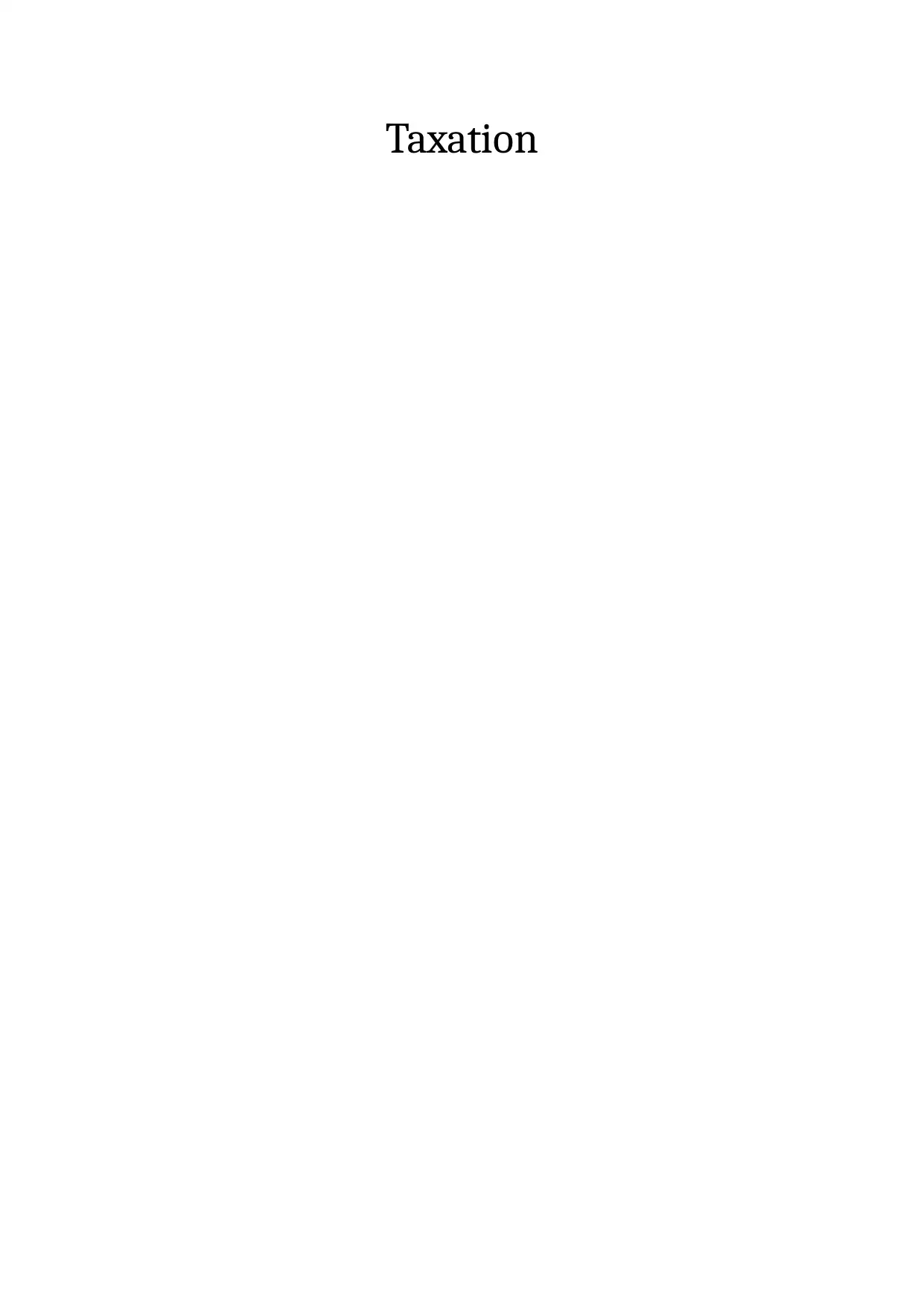
Taxation
Secure Best Marks with AI Grader
Need help grading? Try our AI Grader for instant feedback on your assignments.

TABLE OF CONTENTS
Answer 1....................................................................................................................................3
Answer 2....................................................................................................................................4
Answer 3....................................................................................................................................5
Answer 4....................................................................................................................................6
Answer 5....................................................................................................................................7
REFERENCES...........................................................................................................................9
Answer 1....................................................................................................................................3
Answer 2....................................................................................................................................4
Answer 3....................................................................................................................................5
Answer 4....................................................................................................................................6
Answer 5....................................................................................................................................7
REFERENCES...........................................................................................................................9
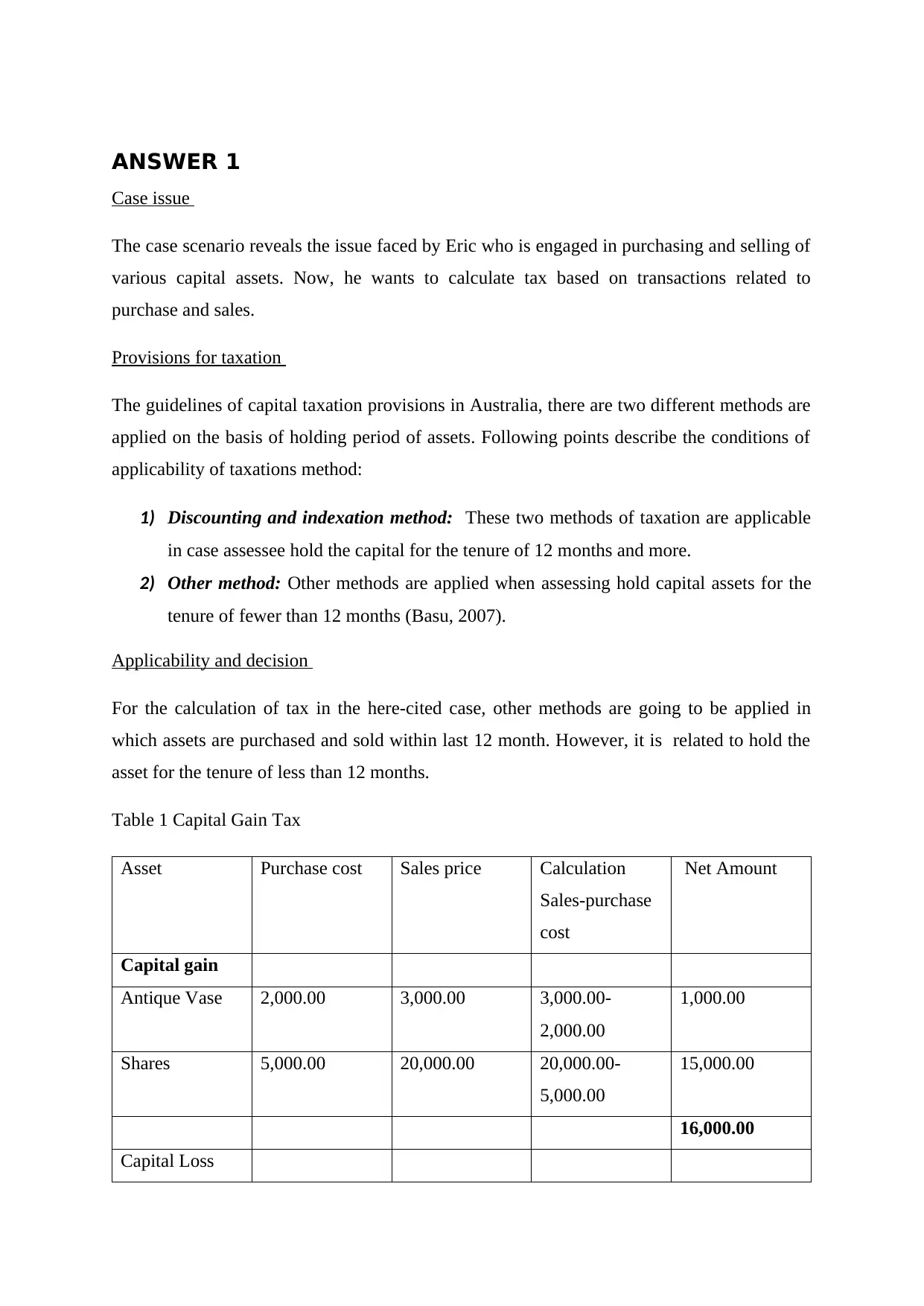
ANSWER 1
Case issue
The case scenario reveals the issue faced by Eric who is engaged in purchasing and selling of
various capital assets. Now, he wants to calculate tax based on transactions related to
purchase and sales.
Provisions for taxation
The guidelines of capital taxation provisions in Australia, there are two different methods are
applied on the basis of holding period of assets. Following points describe the conditions of
applicability of taxations method:
1) Discounting and indexation method: These two methods of taxation are applicable
in case assessee hold the capital for the tenure of 12 months and more.
2) Other method: Other methods are applied when assessing hold capital assets for the
tenure of fewer than 12 months (Basu, 2007).
Applicability and decision
For the calculation of tax in the here-cited case, other methods are going to be applied in
which assets are purchased and sold within last 12 month. However, it is related to hold the
asset for the tenure of less than 12 months.
Table 1 Capital Gain Tax
Asset Purchase cost Sales price Calculation
Sales-purchase
cost
Net Amount
Capital gain
Antique Vase 2,000.00 3,000.00 3,000.00-
2,000.00
1,000.00
Shares 5,000.00 20,000.00 20,000.00-
5,000.00
15,000.00
16,000.00
Capital Loss
Case issue
The case scenario reveals the issue faced by Eric who is engaged in purchasing and selling of
various capital assets. Now, he wants to calculate tax based on transactions related to
purchase and sales.
Provisions for taxation
The guidelines of capital taxation provisions in Australia, there are two different methods are
applied on the basis of holding period of assets. Following points describe the conditions of
applicability of taxations method:
1) Discounting and indexation method: These two methods of taxation are applicable
in case assessee hold the capital for the tenure of 12 months and more.
2) Other method: Other methods are applied when assessing hold capital assets for the
tenure of fewer than 12 months (Basu, 2007).
Applicability and decision
For the calculation of tax in the here-cited case, other methods are going to be applied in
which assets are purchased and sold within last 12 month. However, it is related to hold the
asset for the tenure of less than 12 months.
Table 1 Capital Gain Tax
Asset Purchase cost Sales price Calculation
Sales-purchase
cost
Net Amount
Capital gain
Antique Vase 2,000.00 3,000.00 3,000.00-
2,000.00
1,000.00
Shares 5,000.00 20,000.00 20,000.00-
5,000.00
15,000.00
16,000.00
Capital Loss
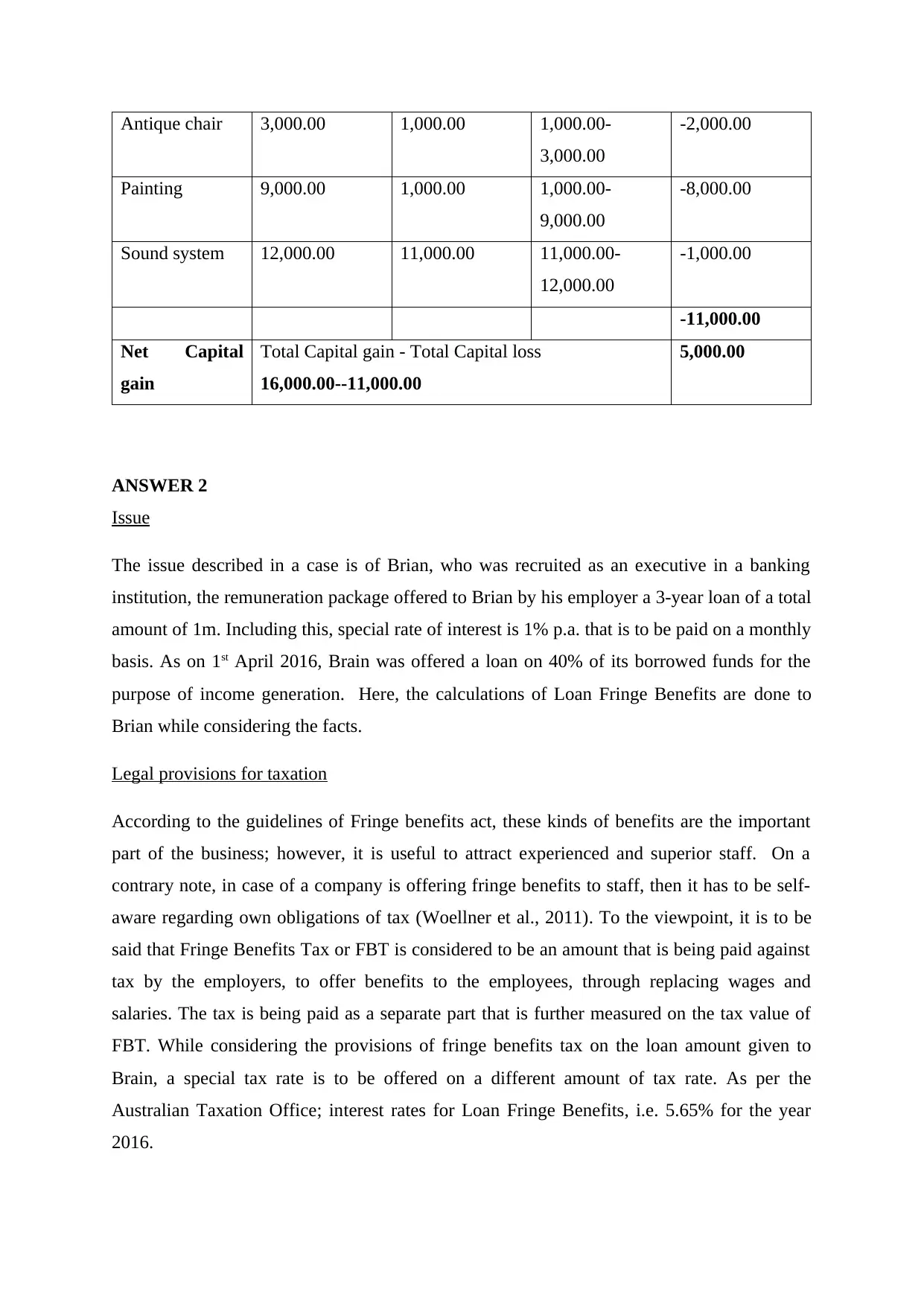
Antique chair 3,000.00 1,000.00 1,000.00-
3,000.00
-2,000.00
Painting 9,000.00 1,000.00 1,000.00-
9,000.00
-8,000.00
Sound system 12,000.00 11,000.00 11,000.00-
12,000.00
-1,000.00
-11,000.00
Net Capital
gain
Total Capital gain - Total Capital loss
16,000.00--11,000.00
5,000.00
ANSWER 2
Issue
The issue described in a case is of Brian, who was recruited as an executive in a banking
institution, the remuneration package offered to Brian by his employer a 3-year loan of a total
amount of 1m. Including this, special rate of interest is 1% p.a. that is to be paid on a monthly
basis. As on 1st April 2016, Brain was offered a loan on 40% of its borrowed funds for the
purpose of income generation. Here, the calculations of Loan Fringe Benefits are done to
Brian while considering the facts.
Legal provisions for taxation
According to the guidelines of Fringe benefits act, these kinds of benefits are the important
part of the business; however, it is useful to attract experienced and superior staff. On a
contrary note, in case of a company is offering fringe benefits to staff, then it has to be self-
aware regarding own obligations of tax (Woellner et al., 2011). To the viewpoint, it is to be
said that Fringe Benefits Tax or FBT is considered to be an amount that is being paid against
tax by the employers, to offer benefits to the employees, through replacing wages and
salaries. The tax is being paid as a separate part that is further measured on the tax value of
FBT. While considering the provisions of fringe benefits tax on the loan amount given to
Brain, a special tax rate is to be offered on a different amount of tax rate. As per the
Australian Taxation Office; interest rates for Loan Fringe Benefits, i.e. 5.65% for the year
2016.
3,000.00
-2,000.00
Painting 9,000.00 1,000.00 1,000.00-
9,000.00
-8,000.00
Sound system 12,000.00 11,000.00 11,000.00-
12,000.00
-1,000.00
-11,000.00
Net Capital
gain
Total Capital gain - Total Capital loss
16,000.00--11,000.00
5,000.00
ANSWER 2
Issue
The issue described in a case is of Brian, who was recruited as an executive in a banking
institution, the remuneration package offered to Brian by his employer a 3-year loan of a total
amount of 1m. Including this, special rate of interest is 1% p.a. that is to be paid on a monthly
basis. As on 1st April 2016, Brain was offered a loan on 40% of its borrowed funds for the
purpose of income generation. Here, the calculations of Loan Fringe Benefits are done to
Brian while considering the facts.
Legal provisions for taxation
According to the guidelines of Fringe benefits act, these kinds of benefits are the important
part of the business; however, it is useful to attract experienced and superior staff. On a
contrary note, in case of a company is offering fringe benefits to staff, then it has to be self-
aware regarding own obligations of tax (Woellner et al., 2011). To the viewpoint, it is to be
said that Fringe Benefits Tax or FBT is considered to be an amount that is being paid against
tax by the employers, to offer benefits to the employees, through replacing wages and
salaries. The tax is being paid as a separate part that is further measured on the tax value of
FBT. While considering the provisions of fringe benefits tax on the loan amount given to
Brain, a special tax rate is to be offered on a different amount of tax rate. As per the
Australian Taxation Office; interest rates for Loan Fringe Benefits, i.e. 5.65% for the year
2016.
Secure Best Marks with AI Grader
Need help grading? Try our AI Grader for instant feedback on your assignments.
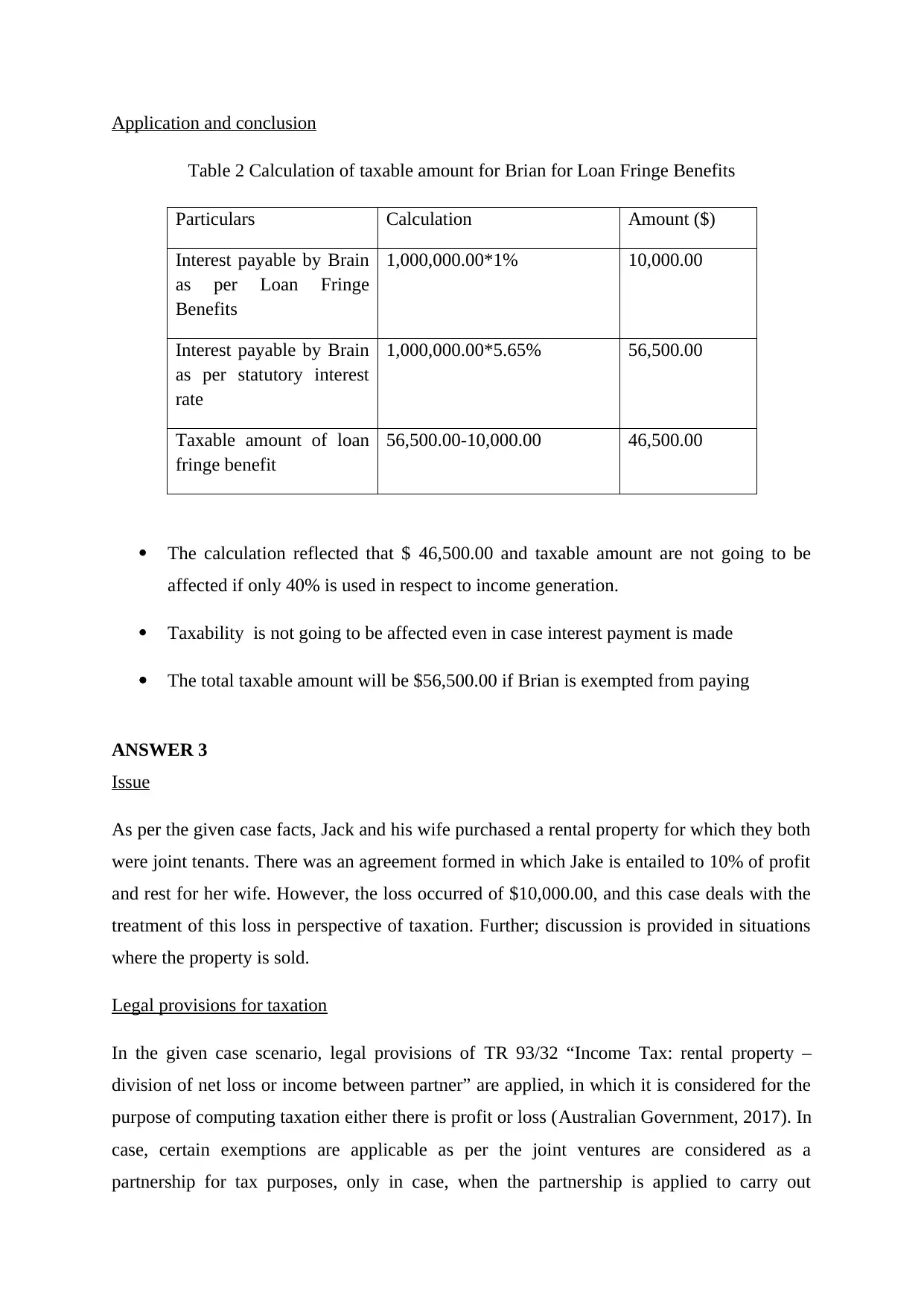
Application and conclusion
Table 2 Calculation of taxable amount for Brian for Loan Fringe Benefits
Particulars Calculation Amount ($)
Interest payable by Brain
as per Loan Fringe
Benefits
1,000,000.00*1% 10,000.00
Interest payable by Brain
as per statutory interest
rate
1,000,000.00*5.65% 56,500.00
Taxable amount of loan
fringe benefit
56,500.00-10,000.00 46,500.00
The calculation reflected that $ 46,500.00 and taxable amount are not going to be
affected if only 40% is used in respect to income generation.
Taxability is not going to be affected even in case interest payment is made
The total taxable amount will be $56,500.00 if Brian is exempted from paying
ANSWER 3
Issue
As per the given case facts, Jack and his wife purchased a rental property for which they both
were joint tenants. There was an agreement formed in which Jake is entailed to 10% of profit
and rest for her wife. However, the loss occurred of $10,000.00, and this case deals with the
treatment of this loss in perspective of taxation. Further; discussion is provided in situations
where the property is sold.
Legal provisions for taxation
In the given case scenario, legal provisions of TR 93/32 “Income Tax: rental property –
division of net loss or income between partner” are applied, in which it is considered for the
purpose of computing taxation either there is profit or loss (Australian Government, 2017). In
case, certain exemptions are applicable as per the joint ventures are considered as a
partnership for tax purposes, only in case, when the partnership is applied to carry out
Table 2 Calculation of taxable amount for Brian for Loan Fringe Benefits
Particulars Calculation Amount ($)
Interest payable by Brain
as per Loan Fringe
Benefits
1,000,000.00*1% 10,000.00
Interest payable by Brain
as per statutory interest
rate
1,000,000.00*5.65% 56,500.00
Taxable amount of loan
fringe benefit
56,500.00-10,000.00 46,500.00
The calculation reflected that $ 46,500.00 and taxable amount are not going to be
affected if only 40% is used in respect to income generation.
Taxability is not going to be affected even in case interest payment is made
The total taxable amount will be $56,500.00 if Brian is exempted from paying
ANSWER 3
Issue
As per the given case facts, Jack and his wife purchased a rental property for which they both
were joint tenants. There was an agreement formed in which Jake is entailed to 10% of profit
and rest for her wife. However, the loss occurred of $10,000.00, and this case deals with the
treatment of this loss in perspective of taxation. Further; discussion is provided in situations
where the property is sold.
Legal provisions for taxation
In the given case scenario, legal provisions of TR 93/32 “Income Tax: rental property –
division of net loss or income between partner” are applied, in which it is considered for the
purpose of computing taxation either there is profit or loss (Australian Government, 2017). In
case, certain exemptions are applicable as per the joint ventures are considered as a
partnership for tax purposes, only in case, when the partnership is applied to carry out
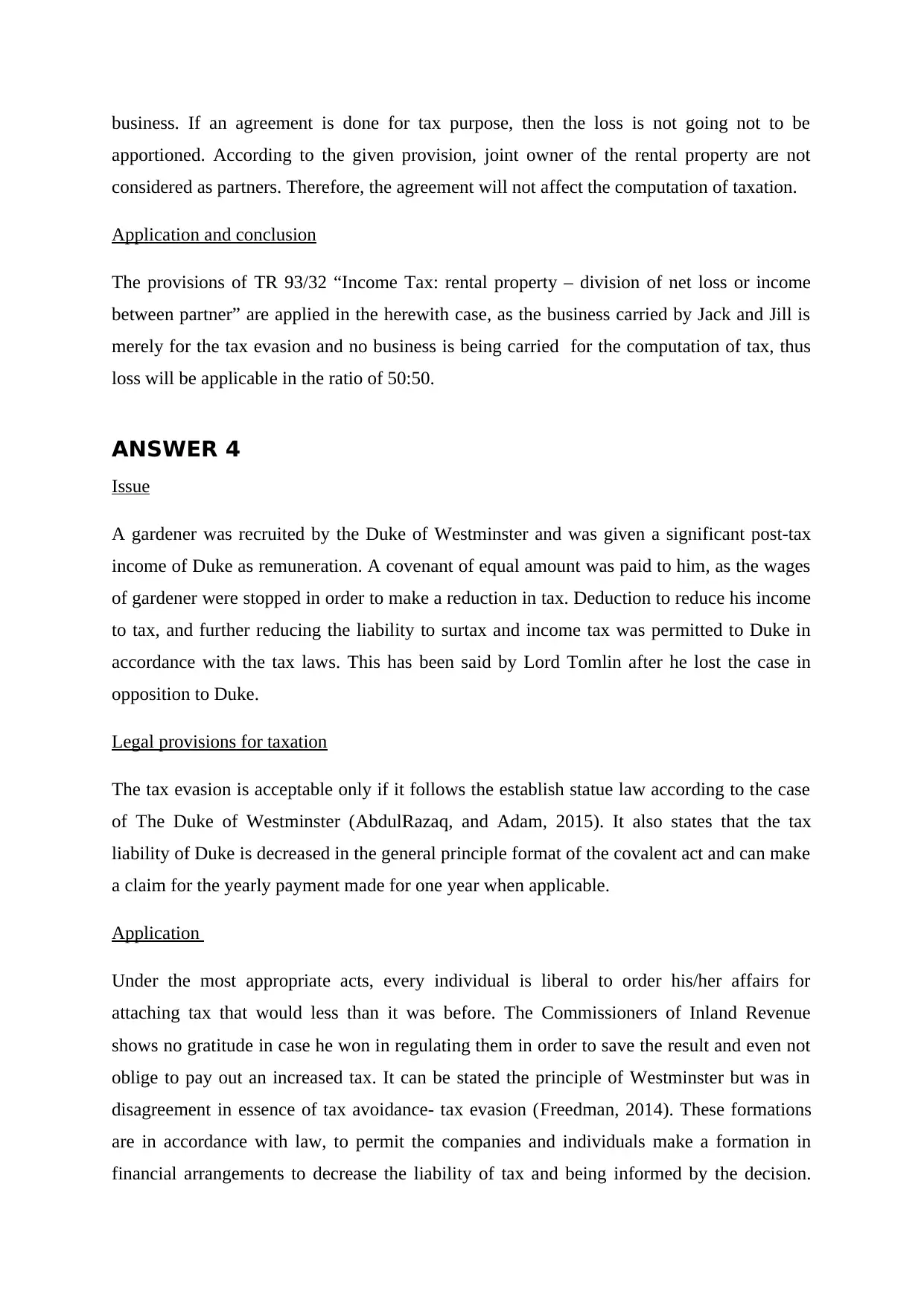
business. If an agreement is done for tax purpose, then the loss is not going not to be
apportioned. According to the given provision, joint owner of the rental property are not
considered as partners. Therefore, the agreement will not affect the computation of taxation.
Application and conclusion
The provisions of TR 93/32 “Income Tax: rental property – division of net loss or income
between partner” are applied in the herewith case, as the business carried by Jack and Jill is
merely for the tax evasion and no business is being carried for the computation of tax, thus
loss will be applicable in the ratio of 50:50.
ANSWER 4
Issue
A gardener was recruited by the Duke of Westminster and was given a significant post-tax
income of Duke as remuneration. A covenant of equal amount was paid to him, as the wages
of gardener were stopped in order to make a reduction in tax. Deduction to reduce his income
to tax, and further reducing the liability to surtax and income tax was permitted to Duke in
accordance with the tax laws. This has been said by Lord Tomlin after he lost the case in
opposition to Duke.
Legal provisions for taxation
The tax evasion is acceptable only if it follows the establish statue law according to the case
of The Duke of Westminster (AbdulRazaq, and Adam, 2015). It also states that the tax
liability of Duke is decreased in the general principle format of the covalent act and can make
a claim for the yearly payment made for one year when applicable.
Application
Under the most appropriate acts, every individual is liberal to order his/her affairs for
attaching tax that would less than it was before. The Commissioners of Inland Revenue
shows no gratitude in case he won in regulating them in order to save the result and even not
oblige to pay out an increased tax. It can be stated the principle of Westminster but was in
disagreement in essence of tax avoidance- tax evasion (Freedman, 2014). These formations
are in accordance with law, to permit the companies and individuals make a formation in
financial arrangements to decrease the liability of tax and being informed by the decision.
apportioned. According to the given provision, joint owner of the rental property are not
considered as partners. Therefore, the agreement will not affect the computation of taxation.
Application and conclusion
The provisions of TR 93/32 “Income Tax: rental property – division of net loss or income
between partner” are applied in the herewith case, as the business carried by Jack and Jill is
merely for the tax evasion and no business is being carried for the computation of tax, thus
loss will be applicable in the ratio of 50:50.
ANSWER 4
Issue
A gardener was recruited by the Duke of Westminster and was given a significant post-tax
income of Duke as remuneration. A covenant of equal amount was paid to him, as the wages
of gardener were stopped in order to make a reduction in tax. Deduction to reduce his income
to tax, and further reducing the liability to surtax and income tax was permitted to Duke in
accordance with the tax laws. This has been said by Lord Tomlin after he lost the case in
opposition to Duke.
Legal provisions for taxation
The tax evasion is acceptable only if it follows the establish statue law according to the case
of The Duke of Westminster (AbdulRazaq, and Adam, 2015). It also states that the tax
liability of Duke is decreased in the general principle format of the covalent act and can make
a claim for the yearly payment made for one year when applicable.
Application
Under the most appropriate acts, every individual is liberal to order his/her affairs for
attaching tax that would less than it was before. The Commissioners of Inland Revenue
shows no gratitude in case he won in regulating them in order to save the result and even not
oblige to pay out an increased tax. It can be stated the principle of Westminster but was in
disagreement in essence of tax avoidance- tax evasion (Freedman, 2014). These formations
are in accordance with law, to permit the companies and individuals make a formation in
financial arrangements to decrease the liability of tax and being informed by the decision.
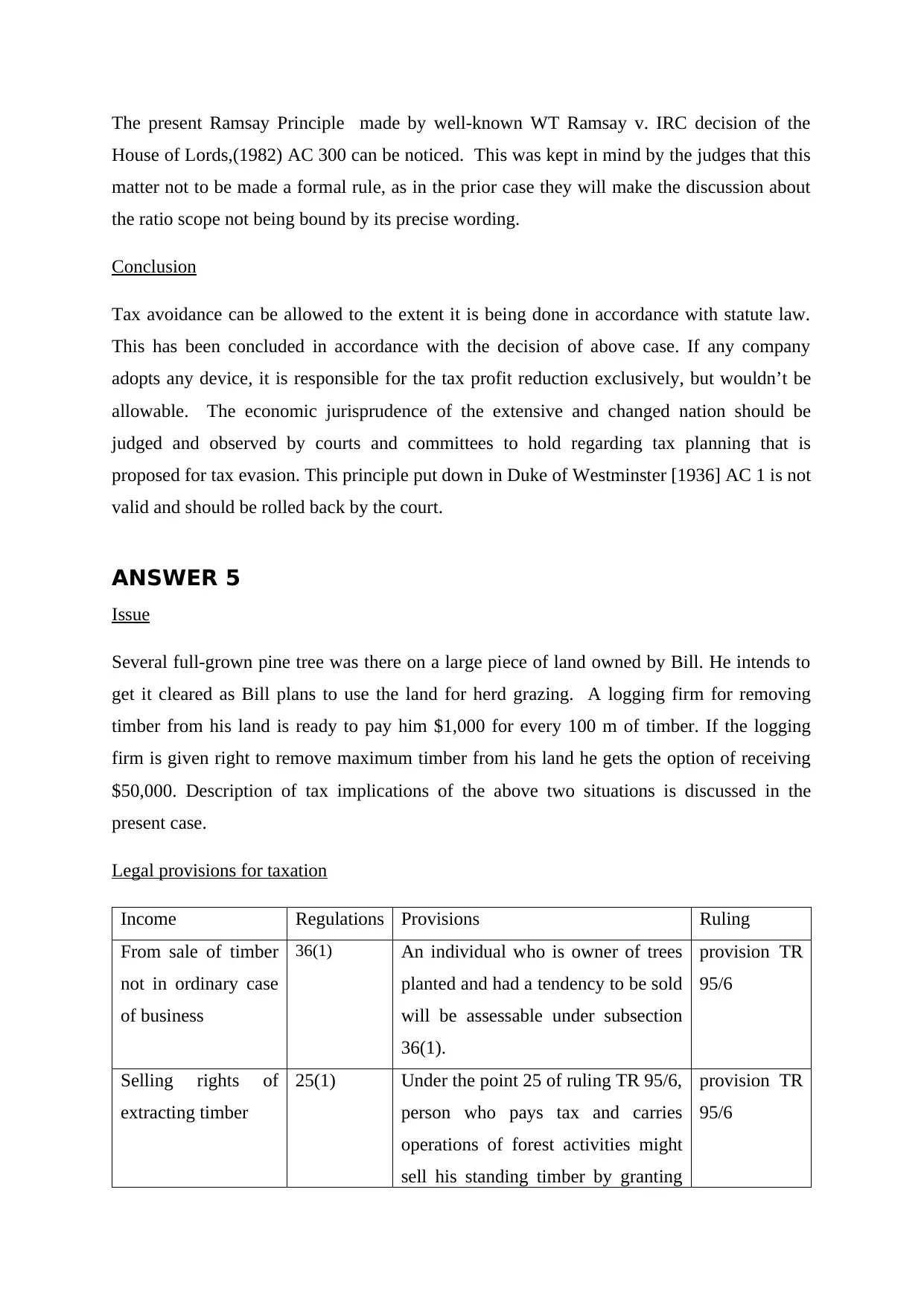
The present Ramsay Principle made by well-known WT Ramsay v. IRC decision of the
House of Lords,(1982) AC 300 can be noticed. This was kept in mind by the judges that this
matter not to be made a formal rule, as in the prior case they will make the discussion about
the ratio scope not being bound by its precise wording.
Conclusion
Tax avoidance can be allowed to the extent it is being done in accordance with statute law.
This has been concluded in accordance with the decision of above case. If any company
adopts any device, it is responsible for the tax profit reduction exclusively, but wouldn’t be
allowable. The economic jurisprudence of the extensive and changed nation should be
judged and observed by courts and committees to hold regarding tax planning that is
proposed for tax evasion. This principle put down in Duke of Westminster [1936] AC 1 is not
valid and should be rolled back by the court.
ANSWER 5
Issue
Several full-grown pine tree was there on a large piece of land owned by Bill. He intends to
get it cleared as Bill plans to use the land for herd grazing. A logging firm for removing
timber from his land is ready to pay him $1,000 for every 100 m of timber. If the logging
firm is given right to remove maximum timber from his land he gets the option of receiving
$50,000. Description of tax implications of the above two situations is discussed in the
present case.
Legal provisions for taxation
Income Regulations Provisions Ruling
From sale of timber
not in ordinary case
of business
36(1) An individual who is owner of trees
planted and had a tendency to be sold
will be assessable under subsection
36(1).
provision TR
95/6
Selling rights of
extracting timber
25(1) Under the point 25 of ruling TR 95/6,
person who pays tax and carries
operations of forest activities might
sell his standing timber by granting
provision TR
95/6
House of Lords,(1982) AC 300 can be noticed. This was kept in mind by the judges that this
matter not to be made a formal rule, as in the prior case they will make the discussion about
the ratio scope not being bound by its precise wording.
Conclusion
Tax avoidance can be allowed to the extent it is being done in accordance with statute law.
This has been concluded in accordance with the decision of above case. If any company
adopts any device, it is responsible for the tax profit reduction exclusively, but wouldn’t be
allowable. The economic jurisprudence of the extensive and changed nation should be
judged and observed by courts and committees to hold regarding tax planning that is
proposed for tax evasion. This principle put down in Duke of Westminster [1936] AC 1 is not
valid and should be rolled back by the court.
ANSWER 5
Issue
Several full-grown pine tree was there on a large piece of land owned by Bill. He intends to
get it cleared as Bill plans to use the land for herd grazing. A logging firm for removing
timber from his land is ready to pay him $1,000 for every 100 m of timber. If the logging
firm is given right to remove maximum timber from his land he gets the option of receiving
$50,000. Description of tax implications of the above two situations is discussed in the
present case.
Legal provisions for taxation
Income Regulations Provisions Ruling
From sale of timber
not in ordinary case
of business
36(1) An individual who is owner of trees
planted and had a tendency to be sold
will be assessable under subsection
36(1).
provision TR
95/6
Selling rights of
extracting timber
25(1) Under the point 25 of ruling TR 95/6,
person who pays tax and carries
operations of forest activities might
sell his standing timber by granting
provision TR
95/6
Paraphrase This Document
Need a fresh take? Get an instant paraphrase of this document with our AI Paraphraser

permission to an individual to cut off
or remove them, if by having rights
or not to cut the timber. The income
earned from the intention of sale is
assessable under subsection 25(1).
Application
In the initial event, the transactions concerned to bill’s disposable standing timber of 100 m
timber for $1000 each to a logging entity, which is not considered in the ordinary course of
business. Section 36(1) is applicable here, and as per this, the income is taxable. Coming to
the next event, the transaction relates to disposable rights of standing timber trees. Section 25
(1) is applicable to this transaction, and the earned income is taxable according to this.
Conclusion
According to the provision applicability stated as above, if the timber has put into a sale then
the revenue earned is assessable as per sec 36(1) , and the standing timber rights are into a
sale than income earned is assessable as per sec 25(1). Moreover, the estimate will be from
the point 25 of ruling TR 95/6.
or remove them, if by having rights
or not to cut the timber. The income
earned from the intention of sale is
assessable under subsection 25(1).
Application
In the initial event, the transactions concerned to bill’s disposable standing timber of 100 m
timber for $1000 each to a logging entity, which is not considered in the ordinary course of
business. Section 36(1) is applicable here, and as per this, the income is taxable. Coming to
the next event, the transaction relates to disposable rights of standing timber trees. Section 25
(1) is applicable to this transaction, and the earned income is taxable according to this.
Conclusion
According to the provision applicability stated as above, if the timber has put into a sale then
the revenue earned is assessable as per sec 36(1) , and the standing timber rights are into a
sale than income earned is assessable as per sec 25(1). Moreover, the estimate will be from
the point 25 of ruling TR 95/6.
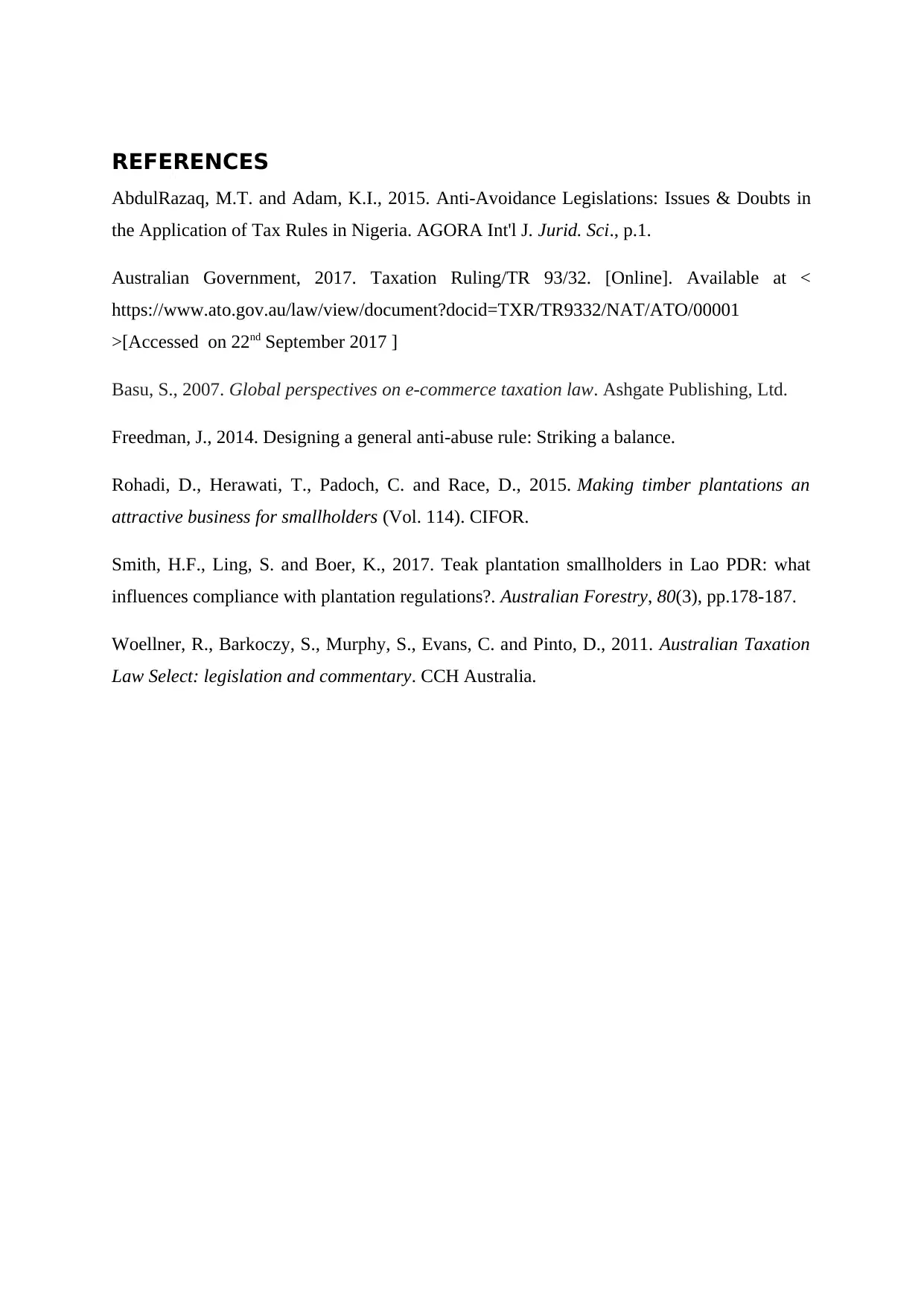
REFERENCES
AbdulRazaq, M.T. and Adam, K.I., 2015. Anti-Avoidance Legislations: Issues & Doubts in
the Application of Tax Rules in Nigeria. AGORA Int'l J. Jurid. Sci., p.1.
Australian Government, 2017. Taxation Ruling/TR 93/32. [Online]. Available at <
https://www.ato.gov.au/law/view/document?docid=TXR/TR9332/NAT/ATO/00001
>[Accessed on 22nd September 2017 ]
Basu, S., 2007. Global perspectives on e-commerce taxation law. Ashgate Publishing, Ltd.
Freedman, J., 2014. Designing a general anti-abuse rule: Striking a balance.
Rohadi, D., Herawati, T., Padoch, C. and Race, D., 2015. Making timber plantations an
attractive business for smallholders (Vol. 114). CIFOR.
Smith, H.F., Ling, S. and Boer, K., 2017. Teak plantation smallholders in Lao PDR: what
influences compliance with plantation regulations?. Australian Forestry, 80(3), pp.178-187.
Woellner, R., Barkoczy, S., Murphy, S., Evans, C. and Pinto, D., 2011. Australian Taxation
Law Select: legislation and commentary. CCH Australia.
AbdulRazaq, M.T. and Adam, K.I., 2015. Anti-Avoidance Legislations: Issues & Doubts in
the Application of Tax Rules in Nigeria. AGORA Int'l J. Jurid. Sci., p.1.
Australian Government, 2017. Taxation Ruling/TR 93/32. [Online]. Available at <
https://www.ato.gov.au/law/view/document?docid=TXR/TR9332/NAT/ATO/00001
>[Accessed on 22nd September 2017 ]
Basu, S., 2007. Global perspectives on e-commerce taxation law. Ashgate Publishing, Ltd.
Freedman, J., 2014. Designing a general anti-abuse rule: Striking a balance.
Rohadi, D., Herawati, T., Padoch, C. and Race, D., 2015. Making timber plantations an
attractive business for smallholders (Vol. 114). CIFOR.
Smith, H.F., Ling, S. and Boer, K., 2017. Teak plantation smallholders in Lao PDR: what
influences compliance with plantation regulations?. Australian Forestry, 80(3), pp.178-187.
Woellner, R., Barkoczy, S., Murphy, S., Evans, C. and Pinto, D., 2011. Australian Taxation
Law Select: legislation and commentary. CCH Australia.
1 out of 9
Related Documents
Your All-in-One AI-Powered Toolkit for Academic Success.
+13062052269
info@desklib.com
Available 24*7 on WhatsApp / Email
![[object Object]](/_next/static/media/star-bottom.7253800d.svg)
Unlock your academic potential
© 2024 | Zucol Services PVT LTD | All rights reserved.





